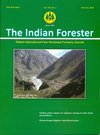Impact of Invasive Plants on the Structure and Composition of Natural Vegetation of Timli Range, Dehradun
DOI:
https://doi.org/10.36808/if/2018/v144i2/122498Keywords:
Diversity, Dominance, Importance Value Index (IVI), Invasive Weeds, Species Richness, Vegetational Analysis.Abstract
Invasive species are a major component of changing patterns of biodiversity around the world. The species that modify the habitat in a major way by preventing the establishment of other species over the long term will themselves generate major shifts in biodiversity. If not checked at this juncture, will affect not only the biodiversity alone but the whole ecosystem. During the past three decades, because of increased pace of development and interference of humans through introduction of invasive exotics, the ecology of the Timli range has changed tremendously. Ragweed (Parthenium hysterophorus), goat weed (Ageratum conyzoides) and lantana (Lantana camara) - the three exotics from South America have caused much harm in the area, because of their invasive potential. A study conducted to assess the changes in the structural composition and dynamics of the vegetation shows that density and diversity of the native flora were adversely affected because of invasion by these exotics. As all the three exotic weeds are known to exhibit allelopathy, it might be one of the major non resource based hypothesis for the successful invasion by these exotic species.References
Baker H.G. (1974). The evolution of weeds. Annual Review of Ecology and systematic, 5: 1-24.
Bennet S.S.R., Nathani H.P. and Raizada M.B. (1978). Parthenium L. in India- a review and history. Indian J. Forest, 1(2): 128-131.
Burke M.J.W., Virtuosic H.K. and Grime J.P. (1996). An experimental study of plant community invasibility. Ecology, 77(3): 776-790.
Dhawan S.R. and Dhawan P. (1995). The Parthenium menace and its management – an overview. Ad. Plant science, 8(1): 1-20
Heirro J.F. and Callaway B.C. (2003). Effect of environmental variation on the invasion success of a non-indigenous forest herb. Ecological Applications, 11(5): 1336-1348.
Hill M.O. (1973). Diversity and its evenness, a unifying notation and its consequences. Ecology, 54:427–432.
Kushwaha S.P.S. and Tripathi R.S. (2006). Ecology of three Species of Eupatorium: A review. Inter. J Ecology and Environmental Science, 32(4): 301-326.
Kushwaha S.P.S., Tripathi R.S. and Rama Krishnan P.S. (1981). Population dynamics of Eupatorium odoratum in successional environments following slash and burn agriculture. J. Applied Ecology, 18: 529-535.
Ludwig J.A. and Reynolds J.F. (1988). Statistical Ecology, A Primer on Methods and Computing. New York: J. Wiley. 85–103 pp.
Mishra R. (1968). Ecological Work Book. Oxford and IBP Publishing Company, Calcutta, India.
Newman M., Bashkin and Son Y. (1999). Exotic plant species invade hot spots of native plant diversity. Ecological Monographs, 69(1): 25-46.
Pimentel D., McNair S. and Janecka J. (2001). Economic and environmental threats of alien plant, animal, and microbe invasions. Agric. Ecosyst. Environ., 84:1–20.
Sakai A.K., Allendorf F.W. and Holt J.S. (2001). The population biology of invasive species. Annu. Rev. Ecol. Syst., 32:305–332.
Shannon C.E. and Weiner W. (1963). The Mathematical theory of communication. Urbana, IL: University of Illinois Press. 31–35 pp. Simpson E. H. (1969). Measurement of diversity. Nature, 163:688
Singh L., Joshi S.P., Gupta A., Manhas R.K. and Verma N.K. (1999). Demography, Diversity and distribution patterns of weeds in response to different regimes of fertilizers in rice crop of Doon Valley. World Weeds, 6:133-142
Turner M.G., Williamson R.H., Dale V.H. and O'Neill R.V. (1989). Predicting the spread of disturbance across heterogeneous landscapes. Ecology, 55: 121-129.
U.P. Forest Department. (1988). Working plan of Timli Forest Division. Dehradun, India: U. P. Forest Department.
Whittaker R.H. (1956). Vegetation of the Great Smoky Mountains. Ecological Monographs, 26(1): 1-80.
Wiser S.K., Allen R.B., Clinton P.W. and Platt K.H. (1998). Community structure and forest invasion by an exotic herb over 23 years. Ecology, 79(6): 2071-2081.
Yadav A.S. and Tripati R.S. (1983). Population dynamics of ruderal weed Eupatorium odoratum and its natural regulation. Oikos, 36: 355-361.
Downloads
Downloads
Published
How to Cite
Issue
Section
License
Unless otherwise stated, copyright or similar rights in all materials presented on the site, including graphical images, are owned by Indian Forester.





